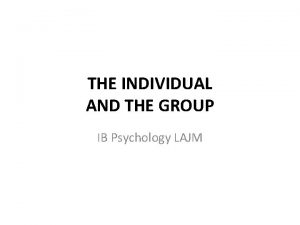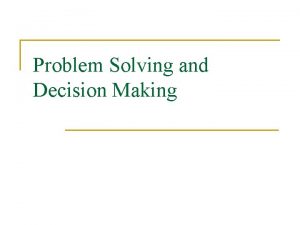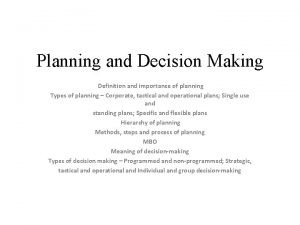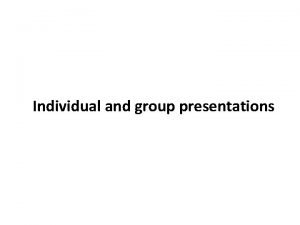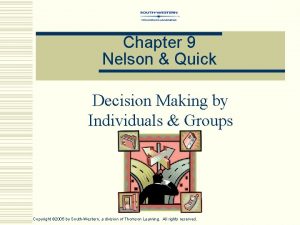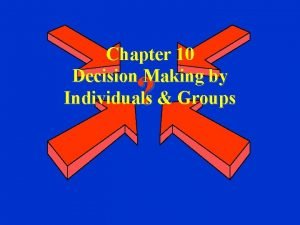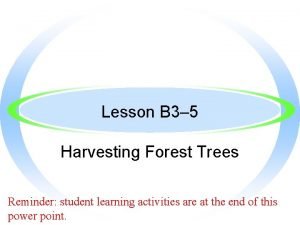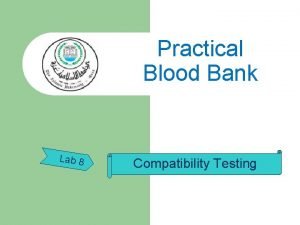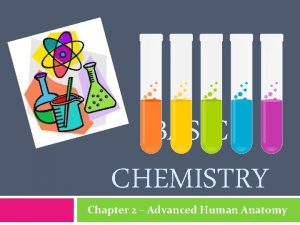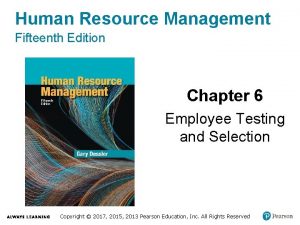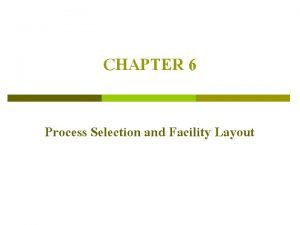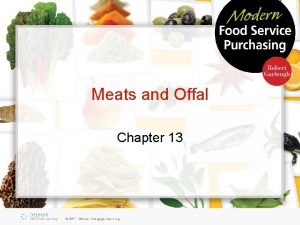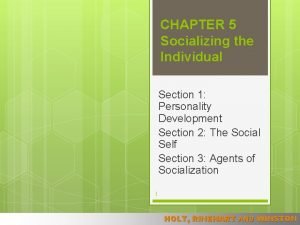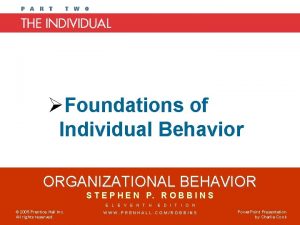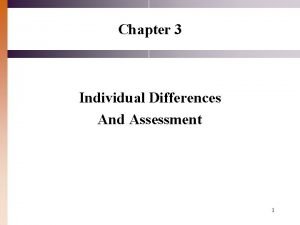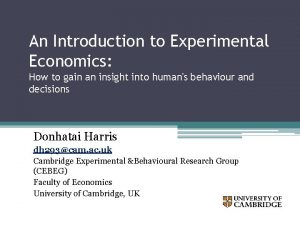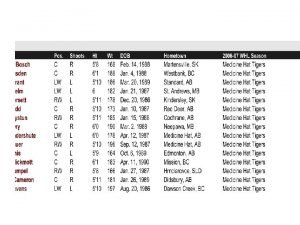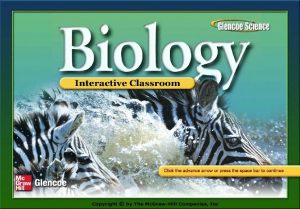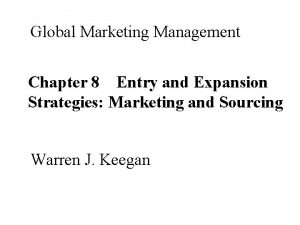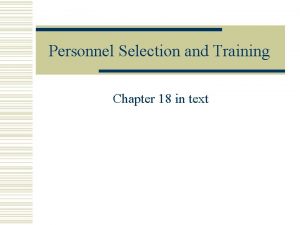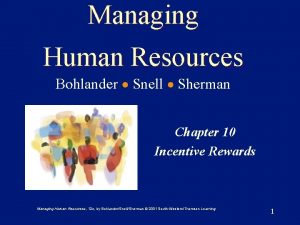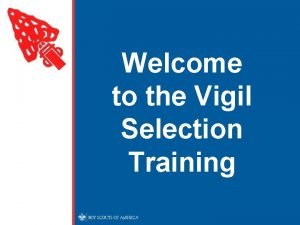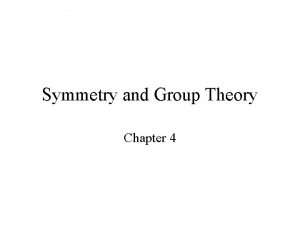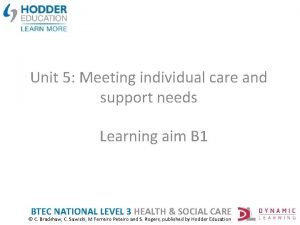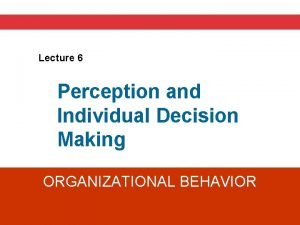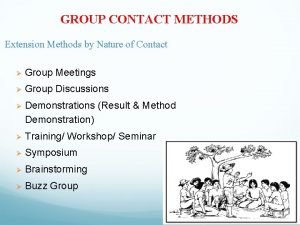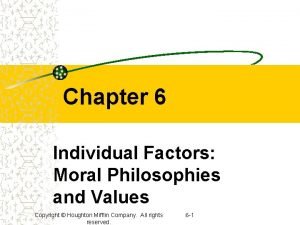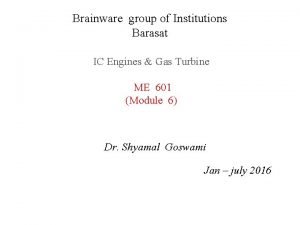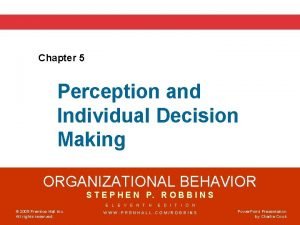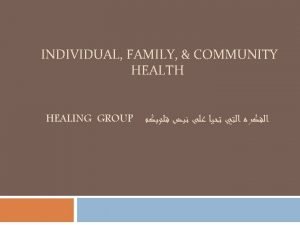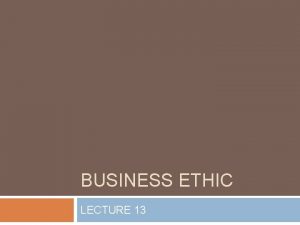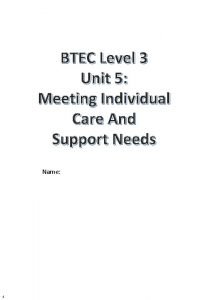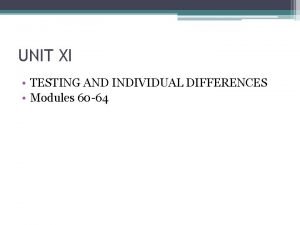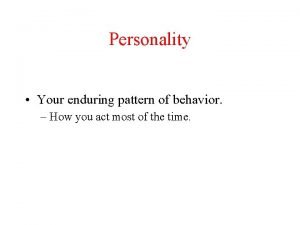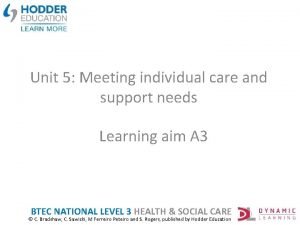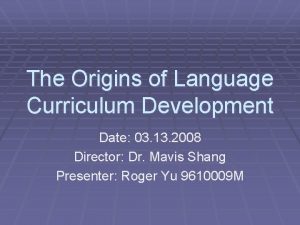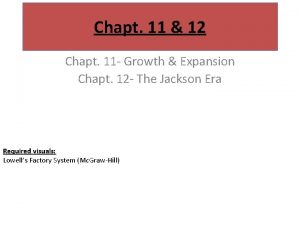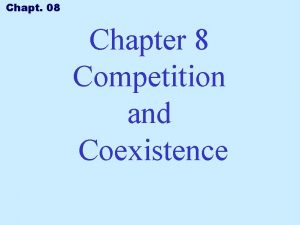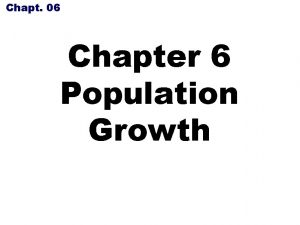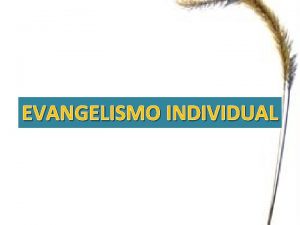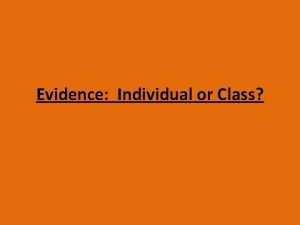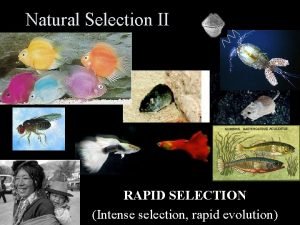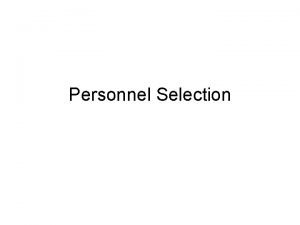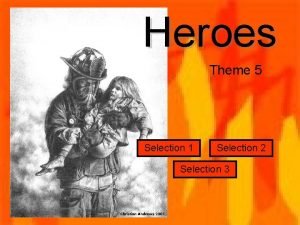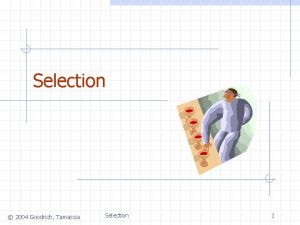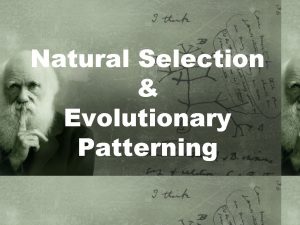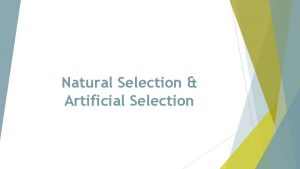Chapt 04 Chapter 4 Group selection and individual
















































































- Slides: 80

Chapt. 04 Chapter 4 Group selection and individual selection © 2002 by Prentice Hall, Inc. Upper Saddle River, NJ 07458

Chapt. 04 2 Outline • Group selection vs. individual selfishness • Altruism • Benefits and trade-offs of group living

Chapt. 04 3 living in Groups:. Increasing Vigilance 警戒. Dilution Effect

Chapt. 04 4 Altruism 利它主義: In an evolutionary sense, enhancement of the fitness of an unrelated individual by acts evolutionary that reduce the fitness of the altruistic individual.

Chapt. 04 5 Kin selection: 同族選擇 A form of genetic selection in which alleles life in their rate of propagation because they influence the survival of in who carry the same alleles.


Chapt. 04 7 5. Natural selection自然選擇: (1). Stabilizing selection穩定選擇: (2). Direction selection定向選擇: (3). Disruptive selection分裂選擇:











Chapt. 04 18 The evolution of interactions among species Mimicry擬態: Coevolution共同演化 Parasitism寄生: Mutualism互利共生: Competition競爭: Predator-prey掠食者與獵物: Herbivore-plant草食性動物與植物:



Chapt. 04 21 Group and Individual Selection • Regulation of populations – early thoughts – Levels below which competition becomes important – Avoid wastefulness – Development of Group Selection • Territoriality of birds

Chapt. 04 22 Group and Individual Selection – Development of Group Selection (cont. ). • Increase in emigration correlated with increase in numbers • Mechanisms operate in the absence of limitations • High variation in reproductive rates • Examples of self-regulation

Chapt. 04 23 Group and Individual Selection • Examples of self-regulation (cont. ). » 1940, David Lack and Alexander Skutch » Self-regulation of song birds » Tropics vs. temperate » Clutch size based on food – 1962, V. C. Wynne-Edwards » Animal Dispersion in Relation to Social Behavior

Chapt. 04 24 Group and Individual Selection » Groups of individuals control their numbers to avoid extinction » Theory known as Group Selection • Successful groups – individuals would not act selfishly • Selfish groups – overexploit their environment and die out. – Development of Individual Selection

Chapt. 04 25 Group and Individual Selection – Development of Individual Selection (cont. ). • 1966, G. C. Williams – Adaptations and Natural Selection – Arguments against Group Selection » Mutation • Cheater scenario • Clutch size based on maximizing the number of surviving chicks (Figure 4. 1)

Chapt. 04 26 Group and Individual Selection – Arguments against Group Selection (cont. ). » Immigration • Selfish individuals can migrate to new areas » Individual selection • Individuals die out more quickly than groups • Individual selection a more powerful evolutionary force » Resource prediction

Chapt. 04 27 Group and Individual Selection – Arguments against Group Selection (cont. ). » Resource prediction • • Group selection needs a reliable and predictable source of food • No evidence Self-Regulation – Intraspecific competition – Individuals strive to command as much resources as they can.

Chapt. 04 28 Group and Individual Selection • Self-Regulation (cont. ). – Act in self-interest. » Ex. Male lions that kill existing cubs when they take over pride. Increase their own offspring » Ex. Male langur monkeys kill infants (Figure 4. 2)

Chapt. 04 29 Group and Individual Selection – Act in self-interest. » Ex. Female giant water bugs kill eggs in masses being taken care of by males (Figure 4. 3)

Chapt. 04 30 Altruism • Apparent cooperation – Grooming – Hunting – Warning signals

Chapt. 04 31 Altruism • Caring for copies of one’s genes – Genes in offspring – Coefficient of relatedness = r – Probability of sharing a copy of a particular gene

Chapt. 04 32 Altruism • Probability of sharing a copy of a particular gene (cont. ). – – – Parents to its offspring; r = 0. 5 Brothers and sisters; r = 0. 5 Grandparents to grandchildren; r = 0. 25 Cousins to each other; r = 0. 125 Figure 4. 4

Chapt. 04 grandparents 0. 25 33 grandparents 0. 25 0. 25 father mother aunt/ uncle 1 self mate 0. 5 daughter or son 0. 25 granddaughter or grandson 0. 5 0. 25 0. 125 half sib cousin brother/ sister (full sib) 0. 25 niece or nephew

Chapt. 04 34 Altruism – Coefficient of relatedness = r (cont. ). • Implications of relatedness to altruism – 1964, W. D. Hamilton – Importance of passing on one’s genes through offspring as well as related individuals.

Chapt. 04 35 Altruism – Coefficient of relatedness = r • Implications of relatedness to altruism (cont. ). – Inclusive fitness » Total copies of genes passed on to all relatives – Kin selection » Lowers individual chance of reproduction

Chapt. 04 36 Altruism – Kin selection » Raises chances of relatives’ reproduction » Quantifying kin selection • r. B – C > 0 • r = coefficient of relatedness • C = number of offspring sacrificed by donor • B = number of offspring gained by recipient

Chapt. 04 37 Altruism – Kin selection (cont. ). » Ex. Caterpillars • Aposematic – contain colors to warn predators of bad taste or poison • Datana caterpillars (Figure 4. 5)

Chapt. 04 38 Number of caterpillar species 50 40 30 20 Large family groups Solitary 10 0 Aposematic Cryptic

Chapt. 04 39 Altruism » Ex. Caterpillars (cont. ). • Predator must kill one to learn • Advantage of animals to congregate in groups (Figure 4. 6)

Chapt. 04 40 Altruism » Alarms from ‘sentries’ • Increased risk of being attacked • Animals living near ‘sentry’ most likely relatives • Favors kin selection • Alternative to kin selection – ‘Sentries’ that are forced to live at the fringe – Alert for their own safety – If ‘sentry’ is successful, predator may seek new area – ‘Sentry’ increases chances of own survival

Chapt. 04 41 Altruism • Altruism between unrelated individuals – “You scratch my back, I’ll scratch yours” – Reciprocal altruism

Chapt. 04 42 Altruism • Altruism between unrelated individuals (cont. ). – Evidence • Brooding success correlated to availability of helpers • Social hunting – Benefit: Bigger prey

Chapt. 04 43 Altruism • Social hunting (cont. ). – Cost: Sharing meat • Altruism in social insects – Extreme example of altruism – sterile castes in social insects – Female workers • Rarely reproduce

Chapt. 04 44 Altruism – Female workers (cont. ). • Assist queen with her offspring (eusociality) – Soldier castes (Figure 4. 7)

Chapt. 04 45 Altruism – Social insect reproduction (Table 4. 1)

Chapt. 04 46

Chapt. 04 47 Altruism – Relatedness • Females are diploid • Males are haploid – Formed without meiosis – Each sperm is identical • Sister relatedness – Each daughter receives an identical set of genes from her father

Chapt. 04 48 Altruism • Sister relatedness – Half of a female’s genes come from her diploid mother – Total relatedness of sisters: 0. 5 from father + 0. 25 from mother = 0. 75. – Genetic system termed haplodiploidy – Relatedness and the Queen » Sons and daughters; r = 0. 5

Chapt. 04 49 Altruism • Sister relatedness (cont. ). » Maximize reproductive potential. 50: 50 sex ratio » Average relatedness for sterile workers would be 0. 5 – Relatedness and the Queen » Better for female workers to have more sisters

Chapt. 04 50 Altruism – Relatedness and the Queen » Colonies usually have more females than males • Non-haplodiploid colonies – Termites – Mole rat from South Africa (Figure 4. 8)

Chapt. 04 51 Snake predators may venture into surface burrows Blocked off burrow 5 cm 20 cm Larger “non-workers” act in defense 40 -50 cm Mean burrow length= 545 feet Mean number of animals= 60

Chapt. 04 52 Altruism – Lifestyles that promote eusociality in mammals • Individuals are confined to burrows or nests • Food is abundant enough to support high concentrations of individuals • Adults exhibit parental care

Chapt. 04 53 Altruism • Lifestyles that promote eusociality in mammals • Mothers can manipulate other individuals – Lifestyles that promote eusociality (cont. ). • Heroism is possible

Chapt. 04 54 Group Living • Dense living • Promote intense competition • Significant advantages to compensate

Chapt. 04 55 Group Living • predators (Figure 4. 9)

School cohesion Chapt. 7 04 56 6 5 Few 1 2 3 4 5 6 Predator abundance (streams in rank order) Many

Chapt. 04 57 Group Living • “Many-eyes hypothesis” – Success of predator attacks • Prey alerted to attack (Figure 4. 10)

Chapt. 04 58 Group Living – Success of predator attacks (cont. ). • Ex. Goshawks less successful attacking large flocks of pigeons (Columba palumbus) • The bigger the flock (more eyes) the more likely the prey will be alerted to the presence of a predator (Figure 4. 11)

Chapt. 100 04 59 Attack success (%) 80 60 40 20 0 1 2 -10 11 -50 Number of pigeons in flock 50

Chapt. 04 60 Group Living – Success of predator attacks (cont. ). • Cheating vs. the advantages of not cheating • Selfish-herd theory – Predators usually only take one prey per attack.

Chapt. 04 61 Group Living • Selfish-herd theory (cont. ). – The bigger the herd, the lower the probability of an individual prey being taken – Larger herds are attacked more, but probability of being taken would still favor individual

Chapt. 04 62 Group Living • Selfish-herd theory (cont. ). – Geometry of the selfish herd • 1971, W. D. Hamilton • Prey prefer middle of herd to avoid predator • Predator difficulty in tracking large numbers of prey

Chapt. 04 63 Group Living – Geometry of the selfish herd(cont. ). • Peripheral prey easier to visually isolate • More difficult for predator to reach the center of herd – Large herds are better able to defend themselves

Chapt. 04 64

Chapt. 04 65 Group Living – Conflicting variables • Competition for food • Presence of predator • Figure 4. 12

66 (c) Percentage of time Chapt. 04 Extra scanning in presence of hawk Optimal flock size (a) (b) Increase in aggression by dominants at higher food levels Feeding Fighting Scanning Optimal flock size Percentage of time Optimal flock size

Chapt. 04 67 Group Living – Conflicting variables (cont. ). • Figure 4. 13

Percent of time spent in each activity Chapt. 04 80 68 Scanning 60 Fighting Feeding 40 20 0 1 3 -4 Flock size 6 -7

Chapt. 04 69 Applied Ecology • Tragedy of the Commons – 1968, Garrett Hardin – “Tragedy of the Commons” – Humans and cattle grazing – Carrying capacity of land

Chapt. 04 70 Applied Ecology • Ex. Carrying capacity on a piece of land - 1000 cattle – 10 ranchers share land, each with a 100 cattle – One individual wants to add one cattle more than his/her share » Maximizes his/her profits at expense of others » All of the cattle suffer very little.

Chapt. 04 71 Applied Ecology – Tragedy (cont. ). » What would happen if all ranchers did this? » Overgrazing » Not sustainable environment often – Benefits of the accrue to the individual

Chapt. 04 72 Applied Ecology – Cost of using the environment is usually borne by the entire population

Chapt. 04 73 Summary • Group Selection – Past theory – Population maintained at equilibrium based on group selection • Self-regulation of individuals • Prevent overexploitation of resources

Chapt. 04 74 Summary • Group Selection (cont. ). – Several flaws – mutation, immigration, and resource prediction. – Individual Selection • More likely

Chapt. 04 75 Summary • Explanations for altruism – Kin selection – Caste systems of social insects – Haplodiploid mating systems • Occurrence of eusociality and cooperation – Haplodiploid organisms – Non-Haplodiploid organisms » Confinement to burrows

Chapt. 04 76 Summary • Occurrence of eusociality and cooperation » High food concentrations » Parental care of offspring » Mothers can manipulate other individuals – Non-Haplodiploid organisms Cont. ). » Opportunity for heroism

Chapt. 04 77 Summary • Group Size - Trade offs • Competition for food • Protection from predators

Chapt. 04 78 Discussion Question #1 • If kin selection occurs in nature, how do you think animals recognize their kin?

Chapt. 04 79 Discussion Question #2 • If it is equally valuable for a female to raise her own young or help raise sisters (both having an r = 0. 5), why do we see most females preferentially raising their young?

Chapt. 04 80 Discussion Question #3 • Unrelated vampire bats that roost communally often rest next to the same neighbors every night and sometimes regurgitate meals of blood to their hungry neighbors. How can you explain this apparent act of altruism?
 Two way selection and multiway selection in c
Two way selection and multiway selection in c Two way selection and multiway selection in c
Two way selection and multiway selection in c Mass selection and pure line selection
Mass selection and pure line selection Balancing selection vs stabilizing selection
Balancing selection vs stabilizing selection Similarities
Similarities K selection r selection
K selection r selection Natural selection vs artificial selection
Natural selection vs artificial selection Artificial selection vs natural selection
Artificial selection vs natural selection What is stabilizing selection
What is stabilizing selection What is exponential growth in ecology
What is exponential growth in ecology Natural selection vs artificial selection
Natural selection vs artificial selection The individual and the group ib psychology
The individual and the group ib psychology Individual and group decision making
Individual and group decision making Nature of decision making
Nature of decision making Individual and group decision making
Individual and group decision making Individual & group presentation
Individual & group presentation Individual and group decision making
Individual and group decision making Individual and group decision making
Individual and group decision making Individual and group behaviour
Individual and group behaviour Group selection
Group selection Exchange transfusion blood group selection
Exchange transfusion blood group selection Group selection
Group selection Anova within group and between group
Anova within group and between group Primary group
Primary group Amino group and carboxyl group
Amino group and carboxyl group Amino group and carboxyl group
Amino group and carboxyl group Group 2 specialties
Group 2 specialties Joining together group theory and group skills
Joining together group theory and group skills Chapter 6 employee testing and selection ppt
Chapter 6 employee testing and selection ppt Process selection and facility layout
Process selection and facility layout Layout
Layout Offal define
Offal define Socializing the individual section 3
Socializing the individual section 3 Sociology chapter 5 socializing the individual
Sociology chapter 5 socializing the individual Chapter 20 civil liberties protecting individual rights
Chapter 20 civil liberties protecting individual rights Foundation of individual behaviour
Foundation of individual behaviour Chapter 3 individual assessment
Chapter 3 individual assessment Chapter 20 civil liberties protecting individual rights
Chapter 20 civil liberties protecting individual rights Chapter 20 civil liberties protecting individual rights
Chapter 20 civil liberties protecting individual rights Social trap example
Social trap example Y = a(b)^x
Y = a(b)^x Group 2 nitrates
Group 2 nitrates In group out group
In group out group Group yourself or group yourselves
Group yourself or group yourselves William graham sumner in group out group
William graham sumner in group out group The selection of a research approach
The selection of a research approach Chapter 15 section 1 darwins theory of natural selection
Chapter 15 section 1 darwins theory of natural selection Chapter 8 the international market selection process
Chapter 8 the international market selection process The selection chapter 18
The selection chapter 18 Chapter selection
Chapter selection Chapter selection
Chapter selection Chapter selection
Chapter selection Chapter selection
Chapter selection Recruitment and induction process
Recruitment and induction process Hcl point group
Hcl point group Unit 5 meeting individual care and support needs assignment
Unit 5 meeting individual care and support needs assignment Managing individual differences and behavior
Managing individual differences and behavior Proactive personality
Proactive personality Perception and individual decision making
Perception and individual decision making Societal bilingualism example
Societal bilingualism example Advantages of group method of extension
Advantages of group method of extension Drug distribution system falls into broad categories
Drug distribution system falls into broad categories Individual factors moral philosophies and values
Individual factors moral philosophies and values Individual pump and nozzle system
Individual pump and nozzle system 1. individual demand and consumer surplus
1. individual demand and consumer surplus Class evidence vs individual evidence
Class evidence vs individual evidence What they see
What they see Class evidence can have probative value.
Class evidence can have probative value. Includes the individual and the family community is
Includes the individual and the family community is Meaning of individual behaviour
Meaning of individual behaviour Ethics is personal myth
Ethics is personal myth Btec health and social care unit 5 coursework
Btec health and social care unit 5 coursework Straight piecework plan
Straight piecework plan T. s. eliot tradition and the individual talent
T. s. eliot tradition and the individual talent Unit xi testing and individual differences
Unit xi testing and individual differences Individual product and service decisions
Individual product and service decisions Hans and sybil eysenck personality dimensions
Hans and sybil eysenck personality dimensions Distinguish between individual demand and market demand
Distinguish between individual demand and market demand Martin hoffman empathy theory health and social care
Martin hoffman empathy theory health and social care New and navigation schemes selection of window
New and navigation schemes selection of window The origin of language curriculum development
The origin of language curriculum development











